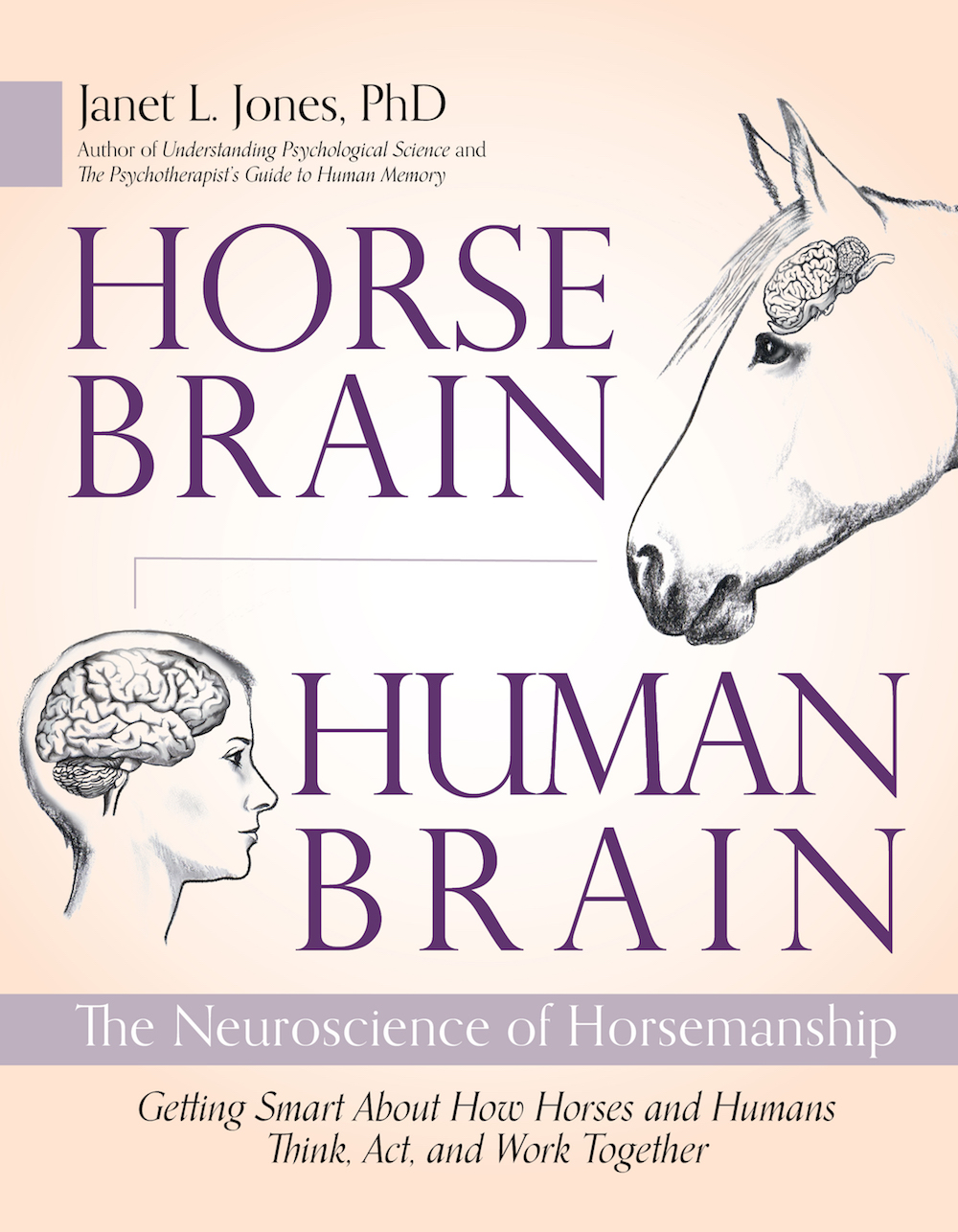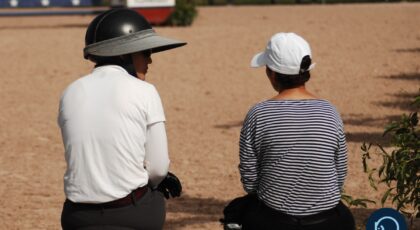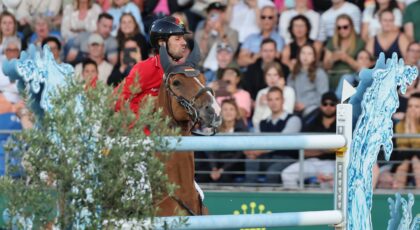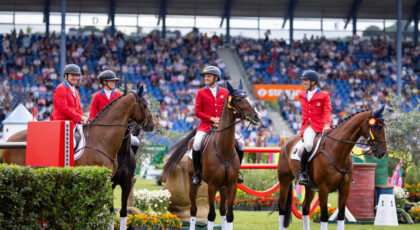True fell in love with the little bay mare in an adjacent turnout about six months ago.
“Fell in love” is a human phrase, of course. True stood as near her as possible every day, riveted his eyes on her in fascination, licked her body with long strokes, became nervous when she went out of sight momentarily, and shooed other geldings away from her. Ten hours a day, seven days a week. Call it whatever you like!
Yesterday, the mare moved away.
This left five other horses nearby, but Trouper was still very upset: pacing the fenceline, ignoring his hay, and whinnying frantically. And when this 1500-pound boy whinnies, it’s LOUD. His entire body shudders.
This is very unusual behavior for True, who has learned to accept quietly the comings and goings of his equine buddies between barn and turnouts. Separation anxiety at its peak!
Too often, people preclude separation anxiety by immediately bringing a horse back to buddies in the barn whenever he seems to miss his friends. But this rewards the horse for pacing, whinnying, ignoring hay, and galloping the fenceline in distress.
Soon you have a horse with no capacity for solitude, no willingness to wait calmly for attention or to look to other adjacent turnout mates for comfort.
And you, at that point, become his servant. Suddenly it is your job to observe all the horses in turnout and bring yours in at the slightest unexpected change.
His buddy’s rider arrived early today? Uh-oh, better bring him in while she rides. Pasture-mate has a farrier appointment? Best to leave your guy in the barn till the farrier is done. So goes the common thought.
Instead of bringing separated horses in, I like to teach them to build calmness and confidence when on their own. This practice also helps with bonding, showing a horse that you are trying to meet his needs.
So, yesterday, instead of leading True to a stall for comfort from an equine barn neighbor, I went to his turnout and began my work.
He spotted me walking to his gate from a quarter mile away. Now that I was there, True danced and fidgeted, calling and calling for his mare. I spoke in a low slow voice, using my “patho-calm” tricks from Chapter 18 of Horse Brain, Human Brain.
True walked rapidly to the fenceline where Miss Universe used to live, then back straight to me. Repeatedly. He searched the empty adjacent turnout with his eyes, then turned them to me. Several times. I got the message.
Meanwhile, all that awful whinnying—every 15 seconds or so, True would pierce the sky with another wail of despair. I ignored the whinnies but stroked his neck each time he was silent. Standard training by reward, folks! It works whether you’re teaching a horse to spin, jump, or manage his emotions.
I walked with him to the fenceline, as if to allow him to show me the problem. Does that help? I have no idea, but it seemed like it might.
He didn’t want to leave his turnout, so I walked him around in there on his halter for 5 or 10 minutes. Soon he was ready to go through the gate. Success! (Note that this success was caused only by waiting for the horse to prepare himself, not by anything I had done. Sometimes, “NOT doing” is the best training technique.)
I groomed and tacked True up nearby, avoiding his giant dancing feet and trying to disregard those deafening whinnies. We went slowly. Whenever my actions pointed him toward greater frenzy, I waited.
Most trainers wouldn’t do that. Standard operating procedure would be to insist that the horse behave, that he toe the line of human time management and get with the program.
I could have demanded that True pass through the open turnout gate the first time I asked. I could have required him to stand still for grooming, yelling “whoa” or jerking his lead rope. I could have scolded him for not following his usual manners.
Some trainers might have tied him down. Or snubbed him to a post to “work out” his frenzy over the missing mare on his own.
Within these schools of thought, the highest priority is immediate obedience. But why? What exactly would all that teach a frightened horse?
This is a herd animal in legitimate emotional distress. Force escalates the problem, rarely works, and precludes the training the horse needs. I didn’t want to teach True to stand still—he already knows that. I wanted to teach him to overcome extreme separation anxiety. Scaring, pressuring, or punishing won’t achieve that goal.
So I continued talking in the low-slow voice and stroking whenever True fell silent. He and I already have a very strong bond, as frequent readers of this column know.
I gave him time, pausing between each of our usual transition spots. Halter – pause – go through gate – pause – groom – pause – saddle up – pause – bridle on – pause, and so on. It really helps to give an equine brain some extra time when trying to teach an anxious horse to calm down.
After half an hour or so, True’s whinnies had decreased to perhaps one a minute. This gave me more opportunity for stroking and praising, reducing whinnies even further.
Mounted, I touched True’s opposite rein whenever he looked to Miss U’s empty turnout, located next to the arena. I redirected his attention, repeatedly but gently every time. Which yes, was often! But soon he was keeping his eyes forward and whinnying even less. Another success!
I maintained True’s attention by giving him some unusual random patterns to walk or trot. We negotiated some trot poles, did serpentines and figure eights in odd places and directions, practiced unexpected gait transitions. Gently, easily, quietly.
Little by little, True calmed.
By the time we cantered, he was no longer whinnying or looking to the mare’s turnout at all. I praised and stroked him, very proud of a horse who learned to calm his emotions at a difficult time. (Plenty of people can’t do that!)
When our ride was finished, perhaps two hours had gone by, well-spent. I returned True to his turnout for the big test. Would he resume his frantic pacing and calling?
I turned him loose but stayed with him, first leading him to water and stroking while he drank. Then over to his hay for some munching. His first few bites were punctuated with sudden head raises, looking for his one true love. But I talked and stroked, and soon Trouper just ate.
Occasionally, he wanted to walk around for a while, and I just meandered around with him. Horses are made to move, so calming often involves allowing or even encouraging them to move.
When I left the turnout—considering the whole session a great success—True lifted his head several times to watch me go. He seemed more concerned about me leaving than about the mare being gone. Which was exactly what I had hoped to do—transfer his anxiety from the mare to me, a person who brings him calmness often, leaves every day but comes back, and therefore is easier to separate from.
Those of you who know Horse Brain, Human Brain will recognize many steps of brain-based horsemanship in this session: Pathological calm, Chapter 18. Training by reward, Chapter 12. Indirect training, Chapter 14. Slow and gradual, Chapter 15. Capturing attention, Chapter 16. Embroidering to maintain attention, Chapter 17. And so on.
My ultimate success yesterday came not only from applying these techniques at the right moments, but also from the deep bond True and I have developed over the past four years. He was listening to me. He trusted me to help him.
To develop a horse without separation anxiety problems, don’t rush him back to the barn for comfort from other horses when one of his buddies leaves. Give him that comfort yourself! Leave him in the difficult location, but stay there for a while and help him become confident on his own.
It can be done. You’ll end up with a deeper horse-human bond and a safer, more secure horse who doesn’t have to be watched every minute.
Related reading:
- The Foundations of All Training
- Why I Don’t Use Fly Masks
- Transcending Time Pressure
- “Hey! She Belongs to Me!”
Brain-Based Horsemanship is a weekly column that chronicles Janet Jones, PhD, and her journey with True, a Dutch Warmblood she trained from age three using neuroscience best practices. Read more about brain-based training in Jones’ award winning book Horse Brain, Human Brain.

A version of this story originally appeared on janet-jones.com. It is reprinted here with permission.


 August 8, 2024
August 8, 2024 

























